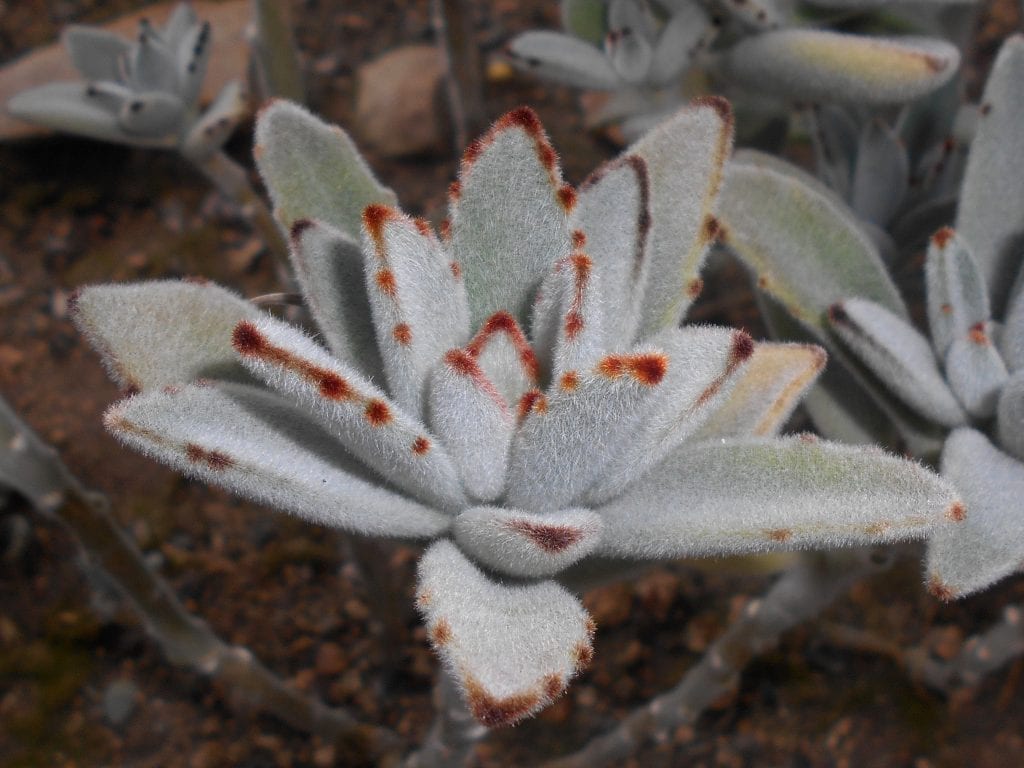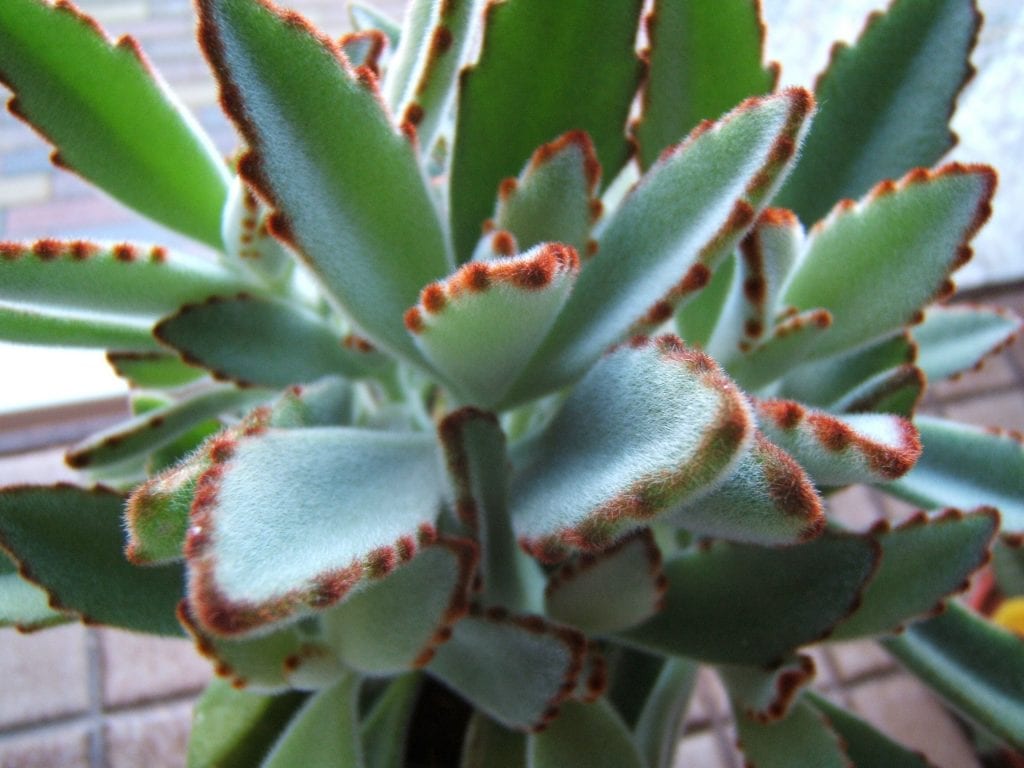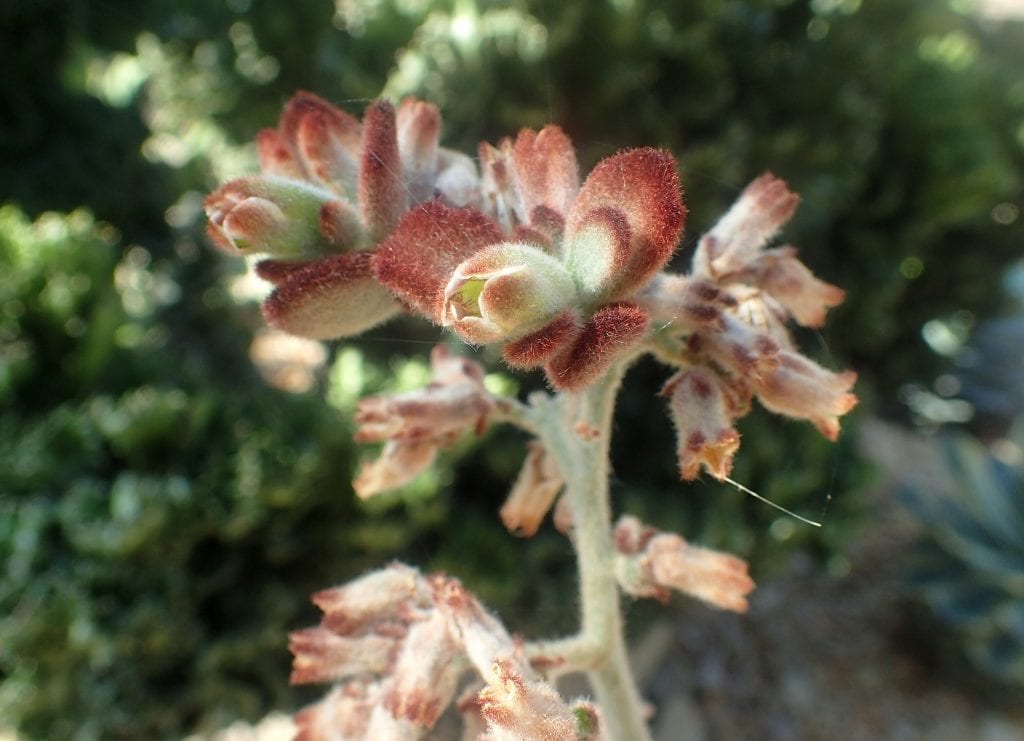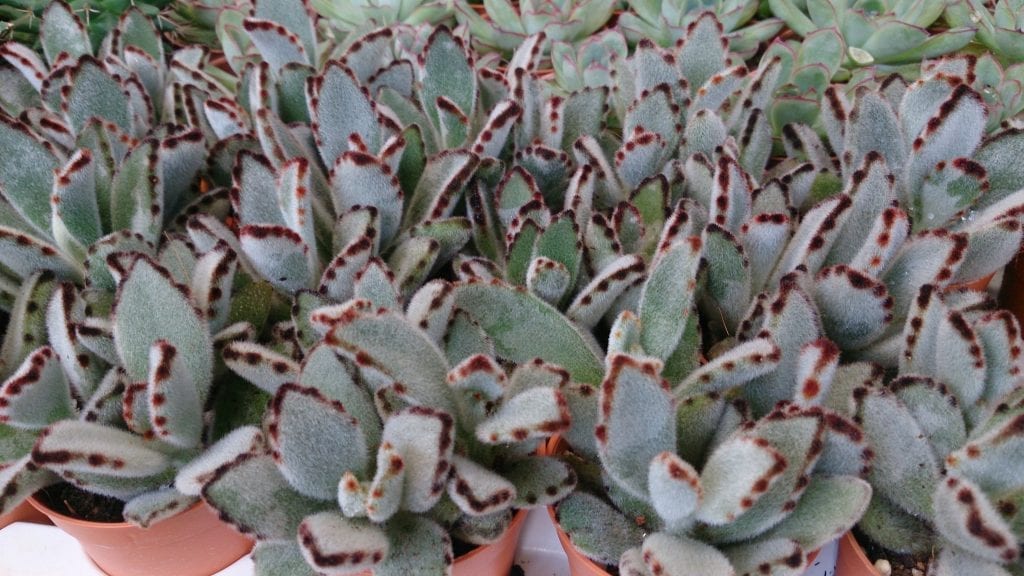
Image - Wikimedia / Salicyna
El kalanchoe tomentosa It is a crass or non-cactus succulent plant that we have more than one and more than two in our collection. It is one of those species that you want to see and even touch over and over again, since it not only has great ornamental value but also has a very soft touch.
Its maintenance is very simple, to the point that it can be had both indoors and outdoors if the weather is good. So, Do you want to meet him?
Origin and characteristics

Image - Wikimedia / Algont
Our protagonist is a crass plant native to Madagascar whose scientific name is kalanchoe tomentosa. It can reach a maximum height of 1 meter, but the normal thing is that it does not exceed 50 centimeters. Its leaves are thick, oblong-lanceolate, covered by very short and fine hairs that give it a plush appearance. The margins are serrated and covered by dark brown spots. The flowers are grouped in tubular salmon or pink inflorescences, and sprout in spring.
Its growth rate is rather slow, which makes taking into account everything that we have said so far it is a most interesting plant to grow in a pot throughout its life.
What are their cares?
If you want to have a copy, we recommend that you provide it with the following care:
Location
This is one of the types of Kalanchoe that can be had both indoors and outdoors, so let's see where it will grow best depending on its location:
- Interior: it must be in a room with plenty of natural light. If you have an interior patio, the better it will be.
- Body exterior:: in semi-shade or in full sun.
Earth

Image - Krzysztof Ziarnek, Kenraiz
It will depend on where it is grown:
- Flower pot: it is highly recommended to mix universal growing medium (on sale here) with perlite (you can get it here) in equal parts.
- Garden: will grow well in soils well drained. In the case that you have a very compact terrain, make a 50x50cm hole and fill it with the mixture of substrates mentioned before.
Irrigation
Bearing in mind that overwatering is one of the most common mistakes when growing Kalanchoes (and indeed any other succulent), how do you know when to water? Well, the best thing to do is check the humidity of the soil or substrate before proceeding to add water. To do this, you must do any of these things:
- Insert a thin wooden stick to the bottom: if it comes out practically clean when you extract it, you don't have to water.
- Weigh the pot once watered and again after a few days: Since wet soil weighs more than dry soil, this difference in weight will serve as a guide to know when to water.
- Using a digital moisture meter: when you enter it, it will tell you instantly how wet the soil that has come into contact with it is. To be more useful, you should introduce it closer / further from the plant since moisture does not lose as fast in all the soil or substrate.
- Dig about two inches next to the plant: if at that depth you see that the earth is cool and darker than on the surface at ground level, do not water.
However, it should generally be watered once or twice a week in summer and every 15 to 20 days the rest of the year.
Subscriber

Image - Wikimedia / Mokkie
So you can have a good development it is necessary to pay it throughout the spring and summer with specific fertilizers for cacti and other succulents, like this one from here, following the indications specified on the product packaging.
Multiplication
By seeds and stem cuttings in spring or summer. Let's see how to proceed according to the case:
Seeds
You have to follow this step by step:
- First, a pot of about 10,5 cm in diameter is filled with universal growing medium mixed with perlite in equal parts.
- Then, it is watered consciously.
- The seeds are then placed on the surface and covered with a very thin layer of substrate.
- Finally, the surface is sprayed with water, and the pot is placed outside, in semi-shade.
Thus they will germinate in about two or three weeks maximum.
Cuttings
To get new copies easily and more or less quickly, just take a piece of stem, let the wound dry for a week, and then plant it in a pot with universal culture substrate mixed with perlite in equal parts. It will emit its own roots in a week or two.
Plagues and diseases
It's very tough; Nevertheless, you have to watch the mollusks (snails and slugs) because they eat their leaves. On this article we tell you how to repel them.
Planting or transplanting time
In spring, when the watering of frost has passed. If it is potted, transplant every two years.
Rusticity
It is very sensitive to cold. Supports up to 5ºC.

Image - Wikimedia / Algont
What did you think of the kalanchoe tomentosa? You can learn much more about Kalanchoes in our guide https://www.jardineriaon.com/kalanchoe.html
Your advice about the care that our plants should have is very good, I am an amateur who feels and values everything we can do so that each one of them feels at home and at the same time giving a touch of joy to ours, because they are living beings just like our dog and our cat deserve the best because in this way we are going to make the time in which we have to pass through this life much more pleasant, simply thank you very much.
Thank you for your comment 🙂
Thanks for such great advice. But I would like to ask a question. I have 3 kalanchoes tomentosa, green, light brown and dark brown. Could you put them together in 1 pot or would it not be very convenient? Thank you.
Hello Fernando.
They are plants that tend to take out numerous suckers, so I personally do not recommend planting them all together, unless the pot is large (about 40 cm in diameter), which then could still look good.
Regards!
good day I have a Kalanchoe that is growing well but the stems tend to fall down even if I put stakes on it, it tends to do so what is the problem? Thank you
Hi Diego.
Do you happen to have it indoors? Or in an area where there is not much clarity?
It is that from what you say it seems that it grows like this due to lack of light. If so, I recommend putting it in a brighter place, but without direct sunlight as it would burn.
A greeting.